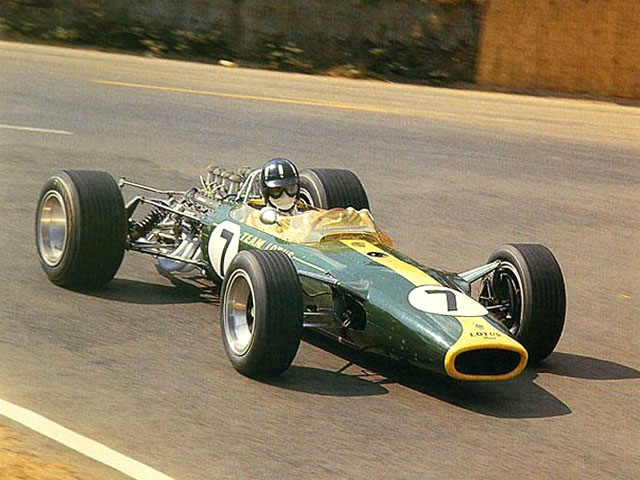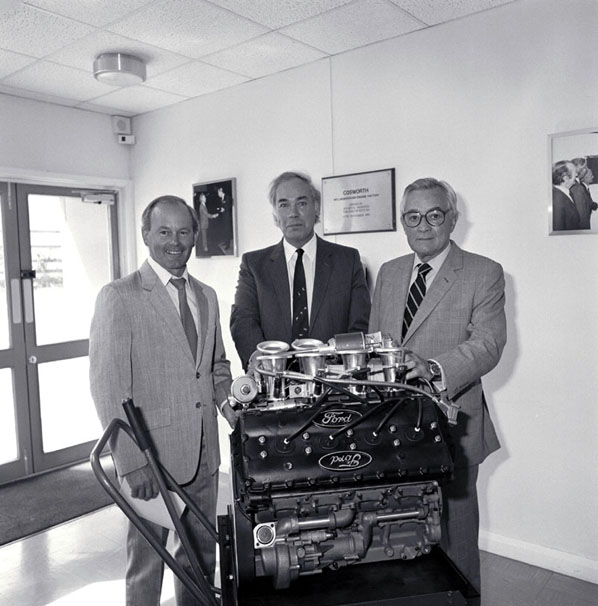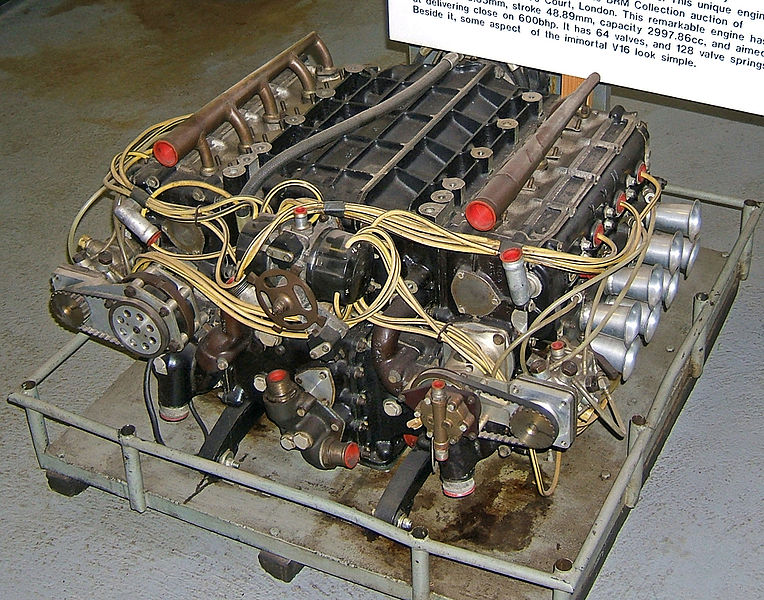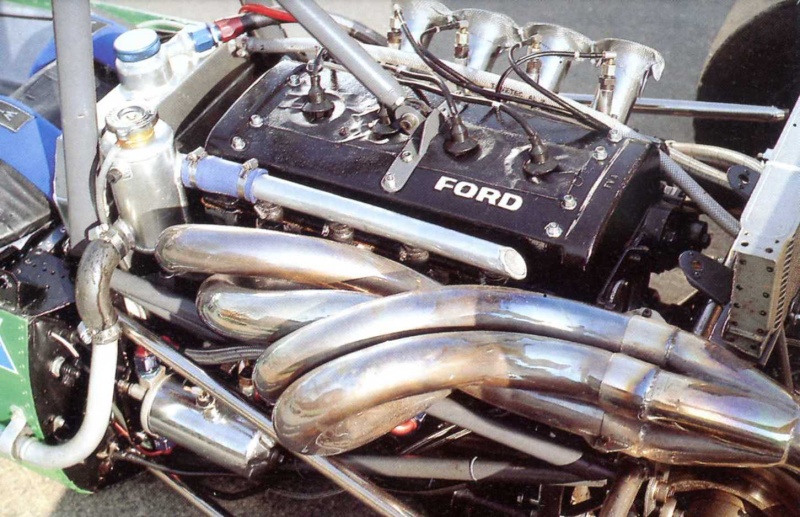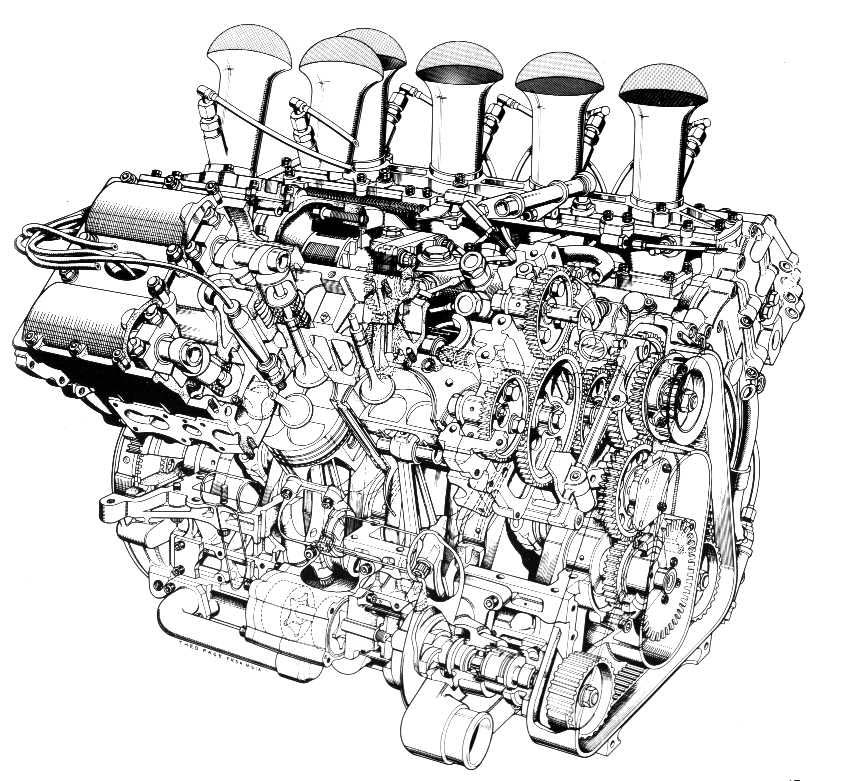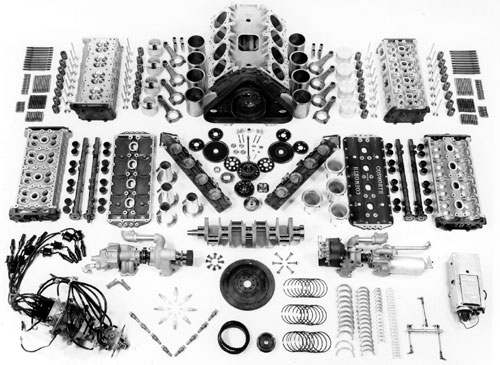As this week is Vintage week, we are looking back to the glory days of racing. The Cosworth DFV engine is in our opinion the most successful engine in Formula 1 history! With over 150 victories and 16 years of racing we can say it is a very special engine.
Lotus 49 in 1967 with the Cosworth DFV powerplant
In late 1964, the Formula 1 regulations were modified by the FIA for 1966. With the new rules two options of engine types would be available for the race teams – a 3l N/A engine and a 1.5l supercharged. The same year Coventry Climax, a well established race engine supplier, announced that after the following year they will not proceed with any further engine developments and retire from the F1 circus. This was serious trouble for most British teams as a major supplier stopped doing business.
L-R – Costin, Duckworth, Hayes behind the Cosworth DFV number 400 in 1987
In 1966 Chapman approached the engine builders for a new Formula 1 engine with no success, after running a modified version of the old 1964 engine without any wins. Soon he tried Ford as a partner and couldn’t establish a business relation. The biggest issue was that many potential supporters wanted more influence on Chapman/Lotus than he was willing to offer. Walter Hayes a Journalist joined Ford as Director of Public Relations, knowing Chapman from earlier and loving motorsports he decided that Ford should join motorsports for promotional and marketing purposes.
BRM H16 – The average engine back in the days was: big, heavy, unreliable
Chapman made a deal with Ford and suggested that Duckworth a former Lotus employee should be in the engineering team. (Duckworth and Costin founded Cos-worth in 1958) Duckworth was approached and a contract with Ford was completed. Ford would fund the development of a 1.6-liter Formula 2 engine and, if successful the second half of the contract would be for the design and manufacture of a 3.0 liter Formula 1 engine. The contract was set and Lotus had an exclusive right for 5 engines in 1967. The value of this deal was around 100k£, a third for the Formula 2 engine and the rest for Formula 1.
Cosworth FVA in 1967
The first engine for Formula 2 purpose was named Cosworth FVA (Four Valve Series-A). To reduce costs the base engine was a Ford Cortina 120E which was tweaked with a 4 valved Cosworth head driven by 5 gears. (no belt!) The engine set a new benchmark for Formula 2. It generated 220bhp out of 1.6l reving up to 9000RPM! This engine dominated Formula 2 racing from 1967 to 1971!
Scetch of the Cosworth DFV
The second engine was the Formula 1 engine and it would use the same concept as the Formula 2. Instead going a complex route like the BRM H16 – Cosworth decided to use a compact V8 and two four valve heads (DFV = Double Four Valve). During development Lotus and Cosworth worked close together, the new 1967 racecar was redesigned to have the engine integrated as a part of the rear monocoque chassis (just like today). The F-O-R-D letters on the engine had nothing to do with Ford in these days, but rather with the 75000£ Ford invested in the development and the first batch of the Cosworth DFV series! The glory days of the DFV were not right from the beginning – numerous problems with oil drainage and cylinder heads had to be solved. Nevertheless on the 25th of April 1967 the engine was delivered to Lotus and the Dutch Grand Prix in the same year was just the first step to a big success story!
If the engines didn’t blow during the race, the Cosworth DFV was always a winner! During the season Chapman had to be convinced to allow other teams to buy the
engine for 1968 and 1969, this is just a reminder of how strong the engine was! From now on starting in Formula 1 racing wasn’t hard anymore. A ready to race package was available from Cosworth and a Hewland gearbox was included. Just the car had to be build! Although Duckworth was adamant that the DFV was a Formula 1 engine – a de-stroked 2.65-liter turbo-charged version would dominate CART racing into the 1980s. When Formula 2 was replaced by Formula F3000 in the mid 80s a new market was opened for the DFV.
Until the Formula 1 turbo era the engine had won over 150 races, 12 driver championships, 10 constructors‘ championships – 24h Le Mans twice (75, 80) – Six times Formula 3000. The DFX as the turbocharged DFV brother won all USAC / CART championships from 1977 to 1987 – And all Indy 500 from 1978 to 1987. The engine was runing over 840bhp in it’s final season! I consider it as the best V8 engine ever developed for motorsport!As this week is Vintage week, we are looking back to the glory days of racing. The Cosworth DFV engine is in our opinion the most successful engine in Formula 1 history! With over 150 victories and 16 years of racing we can say it is a very special engine.
Lotus 49 in 1967 with the Cosworth DFV powerplant
In late 1964, the Formula 1 regulations were modified by the FIA for 1966. With the new rules two options of engine types would be available for the race teams – a 3l N/A engine and a 1.5l supercharged. The same year Coventry Climax, a well established race engine supplier, announced that after the following year they will not proceed with any further engine developments and retire from the F1 circus. This was serious trouble for most British teams as a major supplier stopped doing business.
L-R – Costin, Duckworth, Hayes behind the Cosworth DFV number 400 in 1987
In 1966 Chapman approached the engine builders for a new Formula 1 engine with no success, after running a modified version of the old 1964 engine without any wins. Soon he tried Ford as a partner and couldn’t establish a business relation. The biggest issue was that many potential supporters wanted more influence on Chapman/Lotus than he was willing to offer. Walter Hayes a Journalist joined Ford as Director of Public Relations, knowing Chapman from earlier and loving motorsports he decided that Ford should join motorsports for promotional and marketing purposes.
BRM H16 – The average engine back in the days was: big, heavy, unreliable
Chapman made a deal with Ford and suggested that Duckworth a former Lotus employee should be in the engineering team. (Duckworth and Costin founded Cos-worth in 1958) Duckworth was approached and a contract with Ford was completed. Ford would fund the development of a 1.6-liter Formula 2 engine and, if successful the second half of the contract would be for the design and manufacture of a 3.0 liter Formula 1 engine. The contract was set and Lotus had an exclusive right for 5 engines in 1967. The value of this deal was around 100k£, a third for the Formula 2 engine and the rest for Formula 1.
Cosworth FVA in 1967
The first engine for Formula 2 purpose was named Cosworth FVA (Four Valve Series-A). To reduce costs the base engine was a Ford Cortina 120E which was tweaked with a 4 valved Cosworth head driven by 5 gears. (no belt!) The engine set a new benchmark for Formula 2. It generated 220bhp out of 1.6l reving up to 9000RPM! This engine dominated Formula 2 racing from 1967 to 1971!
Scetch of the Cosworth DFV
The second engine was the Formula 1 engine and it would use the same concept as the Formula 2. Instead going a complex route like the BRM H16 – Cosworth decided to use a compact V8 and two four valve heads (DFV = Double Four Valve). During development Lotus and Cosworth worked close together, the new 1967 racecar was redesigned to have the engine integrated as a part of the rear monocoque chassis (just like today). The F-O-R-D letters on the engine had nothing to do with Ford in these days, but rather with the 75000£ Ford invested in the development and the first batch of the Cosworth DFV series! The glory days of the DFV were not right from the beginning – numerous problems with oil drainage and cylinder heads had to be solved. Nevertheless on the 25th of April 1967 the engine was delivered to Lotus and the Dutch Grand Prix in the same year was just the first step to a big success story!
If the engines didn’t blow during the race, the Cosworth DFV was always a winner! During the season Chapman had to be convinced to allow other teams to buy the
engine for 1968 and 1969, this is just a reminder of how strong the engine was! From now on starting in Formula 1 racing wasn’t hard anymore. A ready to race package was available from Cosworth and a Hewland gearbox was included. Just the car had to be build! Although Duckworth was adamant that the DFV was a Formula 1 engine – a de-stroked 2.65-liter turbo-charged version would dominate CART racing into the 1980s. When Formula 2 was replaced by Formula F3000 in the mid 80s a new market was opened for the DFV.
Until the Formula 1 turbo era the engine had won over 150 races, 12 driver championships, 10 constructors‘ championships – 24h Le Mans twice (75, 80) – Six times Formula 3000. The DFX as the turbocharged DFV brother won all USAC / CART championships from 1977 to 1987 – And all Indy 500 from 1978 to 1987. The engine was runing over 840bhp in it’s final season! I consider it as the best V8 engine ever developed for motorsport!
